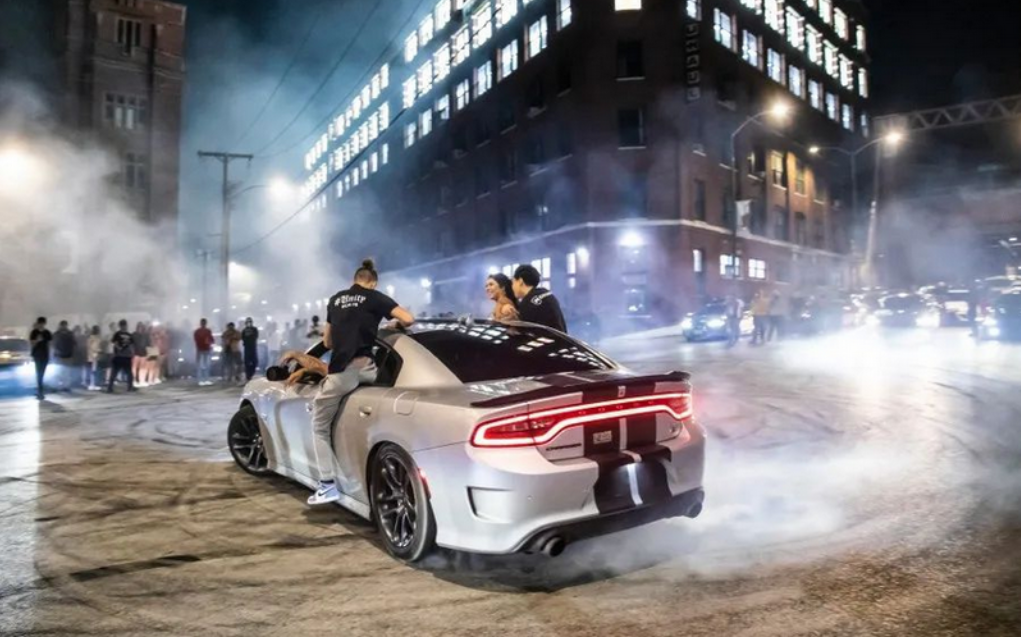Understanding Street Takeover
Street takeovers, often referred to as “sideshows,” have become a controversial phenomenon in urban areas across the United States. These events typically involve groups of drivers and spectators gathering in a designated area, usually an intersection, to perform dangerous stunts such as drifting, doughnuts, and other reckless driving behaviors. The gatherings can attract large crowds, leading to significant disruptions and safety hazards for both participants and the public.
Definition and Characteristics
Street Takeover: A street takeover is an informal gathering where participants block off streets to perform automotive stunts. These events can involve:
- Stunt Driving: Drivers perform tricks like donuts or drifting.
- Crowd Participation: Spectators often cheer on drivers, sometimes engaging in reckless behaviors themselves.
- Social Media Coordination: Many takeovers are organized through platforms like Instagram, where participants share locations and times.
Historical Context
The rise of street takeovers can be traced back to the early 2000s but has gained significant traction during the COVID-19 pandemic. With many public spaces empty due to lockdowns, these events became more prevalent as people sought entertainment and thrills in their communities. Reports indicate that incidents of street takeovers surged significantly in major cities like Los Angeles, where the Los Angeles Police Department (LAPD) reported a dramatic increase in such events from 500 in early 2021 to over 700 in the same timeframe in 2022.
Legal Implications
Street takeovers are illegal activities that can lead to severe legal consequences for participants. Depending on the jurisdiction, participants may face charges such as:
- Reckless Driving: This can lead to fines and imprisonment.
- Public Endangerment: Organizers and participants can be charged with endangering public safety.
- Property Damage: If property is damaged during a takeover, additional charges may apply.
In California, for instance, reckless driving can result in a fine up to $1,000 and potential jail time.
Safety Concerns
The dangers associated with street takeovers are significant. Reports have documented numerous injuries and fatalities linked to these events. For example, in Los Angeles alone, at least six people died during or near street takeovers within a short period. The chaotic nature of these gatherings often leads to violence, property destruction, and serious traffic accidents.
Community Response
Local governments and law enforcement agencies have struggled to manage street takeovers effectively. Many cities have implemented various strategies to curb these activities:
- Increased Policing: Some jurisdictions have formed specialized task forces to monitor and respond to street takeovers.
- Community Engagement: Officials are working with community leaders to address the root causes of these events and promote safer alternatives for car enthusiasts.
- Legislation: Some areas are considering stricter laws against organizing or participating in street takeovers.
Case Studies
Los Angeles
Los Angeles has seen a particularly high incidence of street takeovers. The LAPD has reported over 600 arrests related to these events since January 2022, highlighting the challenges law enforcement faces in controlling such large gatherings.
Cleveland
In Cleveland, city officials have expressed frustration over the rising number of street takeovers. Following a recent event involving multiple intersections being taken over by stunt drivers, police are now considering felony riot charges against those involved.
Social Media’s Role
Social media plays a crucial role in facilitating street takeovers. Platforms like Instagram allow organizers to quickly disseminate information about upcoming events, leading to larger crowds than ever before. This digital coordination has made it increasingly difficult for law enforcement to preemptively disrupt these gatherings.
Table: Key Aspects of Street Takeovers
| Aspect | Description |
|---|---|
| Definition | Informal gatherings for stunt driving at blocked intersections |
| Common Stunts | Drifting, donuts, ghost riding |
| Legal Consequences | Charges for reckless driving, public endangerment |
| Safety Risks | Injuries, fatalities, property damage |
| Community Response | Increased policing, community engagement initiatives |
| Role of Social Media | Facilitates organization and promotion of events |
FAQ Section
What is a street takeover?
A street takeover is an informal gathering where drivers perform stunts in blocked-off streets while spectators cheer them on.
Are street takeovers legal?
No, street takeovers are illegal activities that can lead to serious legal consequences for participants.
What safety risks are associated with street takeovers?
Street takeovers pose significant risks including injuries, fatalities, property damage, and increased traffic accidents.
How do law enforcement agencies respond to street takeovers?
Law enforcement agencies often form specialized task forces and increase patrols in areas known for frequent takeovers.
What role does social media play in street takeovers?
Social media is used extensively for organizing street takeovers by allowing participants to share locations and details about events quickly.
Conclusion
Street takeovers represent a growing challenge for urban communities across the United States. While they may provide thrill-seeking entertainment for some individuals, the associated risks and legal implications cannot be ignored. As cities continue to grapple with this issue, a multifaceted approach involving law enforcement, community engagement, and legislative action will be essential in addressing the problem effectively.For more detailed information on this topic, you can refer to resources such as Wikipedia or government publications discussing local laws and regulations regarding street racing and takeovers.



